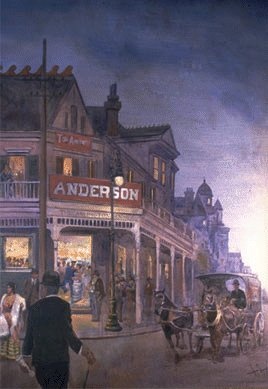Storyville
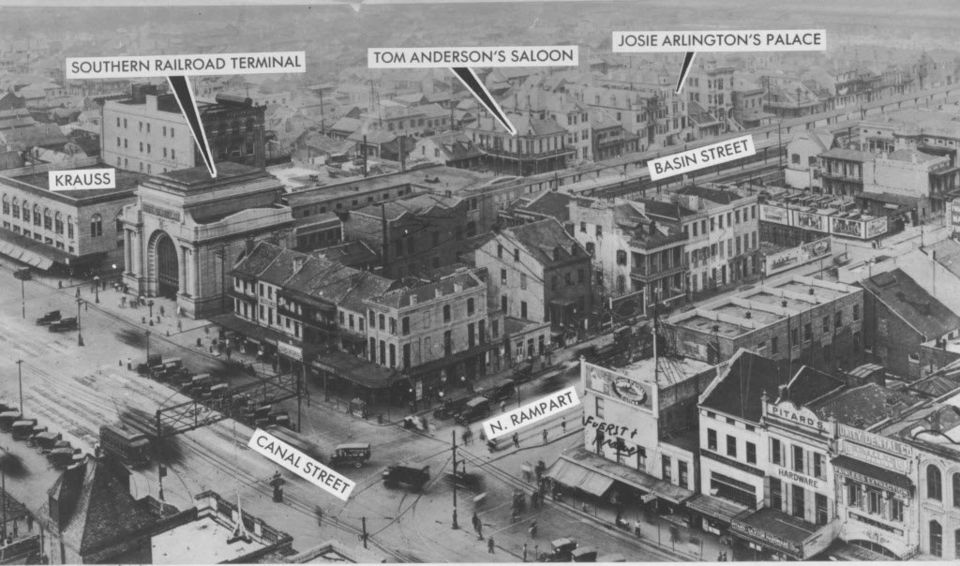
Though developed under the proposed title The District, the nickname Storyville was in reference to City Councilman Sidney Story, who wrote the legislation and guidelines to be followed within the proposed neighborhood limits. The thirty-eight block area was bounded by Iberville, Basin, St. Louis, and N. Robertson streets. His vision came from port cities that legalized prostitution and was officially established on July 6, 1897. Most of this former district is now occupied by the Iberville Housing Projects, two blocks inland from the French Quarter.
The District was set up to limit prostitution to one area of town where authorities could monitor and regulate the practice. In the late 1890s, the New Orleans city government studied the legalized red light districts of northern German and Dutch ports and set up Storyville based on such models. Between 1895 and 1915, "blue books" were published in Storyville. These books were guides to prostitution for visitors to the district's services; they included house descriptions, prices, particular services, and the "stock" each house offered. The Storyville blue-books were inscribed with the motto: "Order of the Garter: Honi Soit Qui Mal Y Pense (Shame to Him Who Evil Thinks)." It took some time for Storyville to gain recognition, but by 1900, Storyville was on its way to becoming New Orleans largest revenue center.
Establishments in Storyville ranged from cheap "cribs" to more expensive houses, up to a row of elegant mansions along Basin Street for well-heeled customers. New Orleans' cribs were 50-cent joints, whereas the more expensive establishments could cost up to $10. Black and white brothels coexisted in Storyville; but black men were barred from legally purchasing services in either black or white brothels. Following the establishment of these brothels, restaurants and saloons began to open in Storyville, bringing in additional tourists.
The District was adjacent to one of the main railway stations, where travelers arrived in the city. It became a noted attraction.
Jazz did not originate in Storyville, but it flourished there as in the rest of the city. Many out-of-town visitors first heard this style of music there before the music spread north.[3] Some outsiders continue to associate Storyville with the origins of jazz. It was tradition in the better Storyville establishments to hire a piano player and sometimes small bands. Famous musicians who got their start in Storyville include Buddy Bolden, Jelly Roll Morton, and Pops Foster.
At the start of World War I, Secretary of War Newton Baker did not want troops to have distractions while deploying.[2] The Navy had troops located in New Orleans and the city was pressed to close Storyville. Prostitution was made illegal in 1917 and Storyville was used for the purpose of entertainment. Most of its buildings were later destroyed, and in 1930 its location was used to create the Iberville housing projects.
Anderson's Annex
The Blue Book
In the early 1900s, a Blue Book could be purchased for 25 cents. Blue Books were created for tourists and those unfamiliar with this area of New Orleans and contained, in alphabetical order, the names of all the prostitutes of Storyville. It also included, in a separate section, the addresses of these prostitutes and separated them based on race. Prostitutes were identified as white, black, or octoroon. Landladies would be identified in bold font and information about popular houses, including interior and exterior pictures, were included. They also included advertisements for national and local cigar makers, distillers, lawyers, restaurants, drugstores, and taxi companies. The fees for general or specific services at the listed brothels were not included.
Blue Books could be purchased throughout the district in various barbershops, saloons, and railroad stations. Primarily they were sold on the corner of Basin Street and Canal Street.
The first Blue Book of Storyville was made between 1895 and 1896, but it wasn’t until 1909 that the first popular edition was published. Billy Struve was its main producer in New Orleans. Struve, a manager of the saloon of Tom Anderson, the “Mayor of Storyville“, published the books on the second floor of Lulu White’s saloon on the corner of Basin Street and Bienville. Approximately sixteen editions were published until 1915. [5]
Mahogany Hall
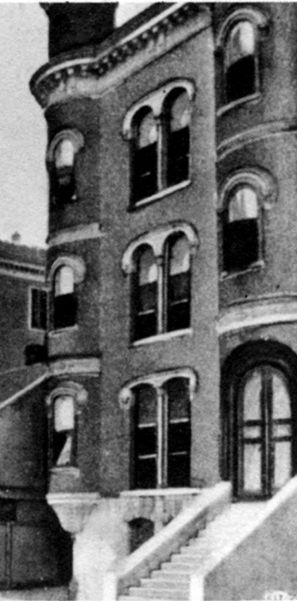
Storyville contained a large variety of brothels and parlors to satisfy the diverse tastes of visitors to New Orleans. Mahogany Hall was the most lavish of them, operated by Lulu White, an important business woman in the district. Mahogany Hall was an octoroon hall, employing prostitutes of mixed races. It was located at 235 Basin Street.
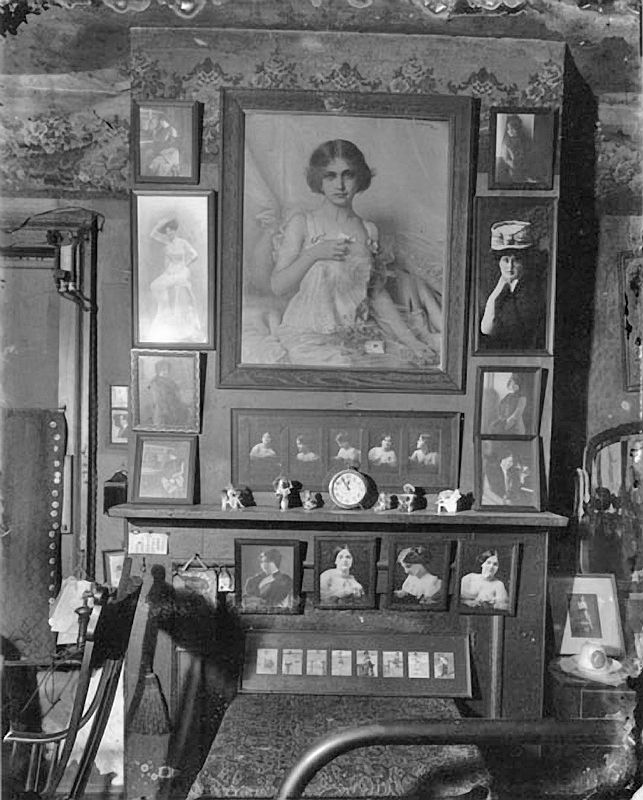
Mahogany Hall employed roughly 40 prostitutes. Popular women of Mahogany Hall included Victoria Hall, Emma Sears, Clara Miller, Estelle Russell, Sadie Reed and Sadie Levy. Lulu White advertised these women to have beautiful figures and a gift from nature, and gained a reputation for having the best women around.
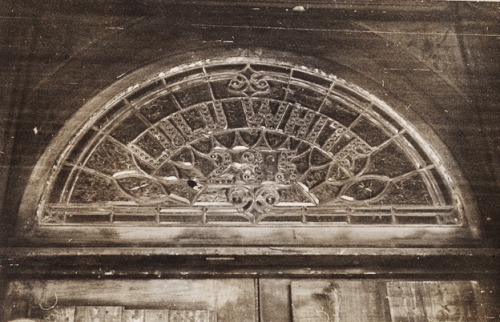
Mahogany Hall was originally called the Hall of Mirrors and was built of solid marble with a stained glass fan window over the entrance door. It had four floors, five different parlors, and fifteen bedrooms with attached bathrooms. The rooms were furnished with chandeliers, potted ferns, and elegant furniture.
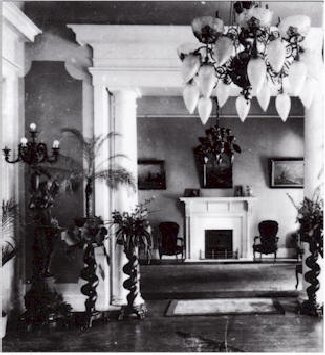
The house was steam-heated, and each bathroom was supplied with hot and cold water. The interiors of the rooms of Mahogany Hall filled the ads in Blue Books and other advertising pamphlets of the period.
The Hall was forced to close down in 1917 following the closure of Storyville. Originally built for $40,000, it did not sell until 1929 when it sold for $11,000. The hall became a House for the Unemployed in the mid-1940s until 1949 when it was finally demolished. However, the significance of the Hall can be found in various museums and in jazz tune “Mahogany Hall Stomp” by Spencer Williams.
Notable People of Storyville
Alderman Sidney Story
Notably the Father of Storyville, Alderman Sidney Story, an American politician, wrote the legislation to set up the District, basing his proposals around other port cities that limited prostitution. Storyville became the nation’s only legal red-light district, due to Ordinance No. 13,032, which forbade any and all prostitution in New Orleans outside of a tightly defined district in 1897.
The original ordinance, written by Story, read:
From the first of October, 1897 it shall be unlawful for any public prostitute or woman
notoriously abandoned to lewdness to occupy, inhabit, live or sleep in any house, room or
closet without the following limits: South Side of Customhouse [Iberville] from Basin to
Robertson street, east side of Robertson street from Customhouse to Saint Louis street,
from Robertson to Basin street.
Story’s vision allowed authority to regulate prostitution without technically legalizing it.
Lulu White
Lulu White was one of the most famous madams in Storyville, running and maintaining Mahogany Hall. She employed 40 prostitutes and sustained a four-story building which housed 15 bedrooms and five parlors. She often found herself in trouble with the law for serving liquor without a license and was known to get violent when another intervened in her practice. Her clients were the most prominent and wealthiest men in Louisiana and she is remembered for her glamour and jewels “which were like the ‘lights of the St. Louis Exposition’ just as reported in her promotional booklet”
Prior to leaving New Orleans, White lost $150,000 in her investment schemes following the closure of Storyville.
Additional brothel proprietors
| Lizette Smith, brothel madam and Tom Anderson's mistress | Kate Thompson | Josie Arlington |
| Willie Piazza | Gertie Livingston | Hilma Burt |
| Jessie Brown | Hattie Hamilton | Tillie Thurman |
| May O'Brien | Maggie Wilson, prostitute | May Tuckerman |
| Flora Meeker | Minnie White | Emma Johnson |
| Diana Ray, co-proprietor of "Diana and Norma's" | Marguerite Griffin, prostitute | Martha Clark |
| Willie Barrera | Gipsy Shafer | Snooks Randella, owner of "The Cairo" |
| Pauline Avery | Eleonora Baquie | Nettie Garbright |
| Hattie Jacobs | Fanny Lambert | Flossie Smith |
| Sabena Weinblat | Emma Berger | Nettie Haley |
| Nellie Gaspar | Maud Flower | Bertha Golden |
| Alice Heard | Effie Dudley | Julia Elliott |
| Cora DeWitt | Sadie Plummer | Millie Christian, aka Mamie Christine |
| Josie Lobrano | Rosie Delaire | Mattie Soner |
| Anna Cahn | May Redmond |
Others
| Thomas C. Anderson, Louisiana state legislator | E. J. Bellocq, photographer | |
| Buddy Bolden, jazz musician | Ann Cook, blues singer | Tony Jackson, musician |
| Frank Lamothe, promoter | Jelly Roll Morton, musician and composer | Jimmie Noone, musician |
| Joe "King" Oliver, musician | Eddie Groshell, dance hall operator | Al Rose, author |
| Frank Early, saloon keeper | Emile Laoume, musician and bandleader | Peter Ciaccio, restauranteur |
| Pops Foster, jazz musician | Richard Egan, grocer, operated the only grocery store in the district | |
| Alcide Nunez, musician | Pete Lala, owner of Pete Lala's Cafe, restaurant and music venue | Louis Armstrong, musician and composer |
Closure
In 1908, a train-route connecting Canal and Basin Street was completed, centralizing the location of Storyville in New Orleans. This new train station was located one block from the District, leading to citizens’ groups protesting its continuance. Prostitutes, often naked, would wave to the train’s passengers from their balconies.
At the beginning of World War I, it was ordered that a brothel could not be located within five miles of a military base. The US Navy, driven by a reformist attitude at home, prohibited soldiers from frequenting prostitutes, based on public health. In October 1917, shortly after the United States entered World War I, Secretary of War Newton D. Baker said:
These boys are going to France. I want them adequately armed and clothed by their government;
but I want them to have an invisible armor to take with them... a moral and intellectual armor
for their protection overseas.
Aided by the campaigns of the American Social Hygiene Organization, and with army regulations that placed such institutes off limits, he implemented a national program to close so-called "segregated zones" close to Army training camps.
In the early days of the war, four soldiers were killed within the district within weeks of each other. The Army and Navy demanded that Storyville be closed down, with the Secretary of the Navy Josephus Daniels citing the district as a "bad influence".
The New Orleans city government strongly protested against closing the district; New Orleans Mayor Martin Behrman said, "You can make it illegal, but you can't make it unpopular." He then ordered the District be shut down by midnight of November 14, 1917. After, separate black and white underground houses of prostitution were set up around the city.
The district continued in a more subdued state as an entertainment center through the 1920s, with various dance halls, cabarets and restaurants. Speakeasies, gambling joints and prostitution were also regularly found in the area despite repeated police raids. Prostitution was made illegal throughout the city in 1917.
Websites
http://www.storyvilledistrictnola.com/portraits.html {historical portraits of Storyville prostitutes}
http://www.atlasobscura.com/places/storyville
https://twentyfourframes.wordpress.com/2013/11/02/e-j-bellocq-storyville-and-pretty-baby/
